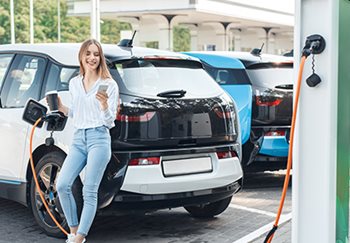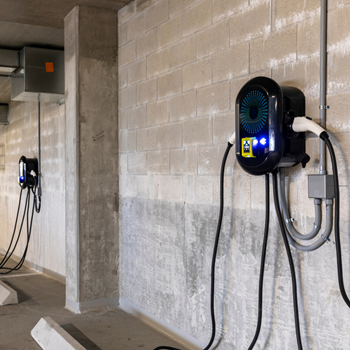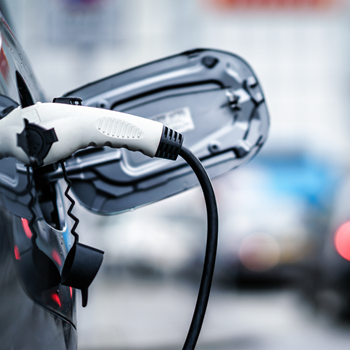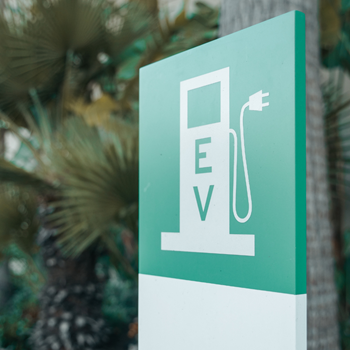How to Set Up EV Charging Stations in Texas High-Rises
With over 200,000 electric vehicles (EVs) now registered in the Lone Star State, it’s a clear sign that more Texans are opting for a greener way to drive. Supporting eco-friendlier roads and the effort to offer more EV charging stations in Texas not only fosters a more sustainable environment, but it also caters to the needs of your residents as members of a condo owners association (COA).
There's no better time to ramp up your EV charging capabilities at your high-rise. To make things easier for you, we've put together a comprehensive list of best practices and action items that will help you become a fully equipped EV-friendly community.
Not only is this the right thing to do for your residents and the environment, but did you know there are several incentives for driving EVs in Texas? For example, EV owners can receive $2,500 in rebates through the Texas Emissions Reduction Program (TERP). And it's not just limited to personal EVs - commercial and fleet vehicles also qualify for incentives. No wonder we’re seeing an increasing number of EVs filling high-rise parking garages!
You may be asking: How can we make the switch to EVs without compromising convenience and accessibility for residents?
That's where this article and list of action items below come in. From identifying the best charging infrastructure design for your community to choosing the right charging stations and service providers, we've got you covered.
It’s time to build a greener, cleaner, and brighter future for our state by joining the effort to install more EV charging stations in Texas.

Pros & cons: shared vs. private EV charging stations in your COA
When it comes to charging options for high-rises and multi-unit buildings, there are two popular choices: a small number (about one to four) of centrally located and shared charging stations, or a larger quantity of resident-owned chargers located in residents' own parking spots. Let’s weigh the pros and cons of each option below.
A few centrally located shared charging stations:
PROS
-Low cost
-Low complexity on equipment and infrastructure
-Smaller electrical capacity requirement
-Lower Impact on electrical demand charges
CONS
-Limited ability to supply power to the association as EVs become more popular
-Vehicle rotation: more valet shifts required; increased wait time; resident inconvenience
-Use of high-demand visitor spots
Resident-owned charging stations in private parking spots:
PROS
-Scalable to serve the entire association
-Convenient
-No implications to valet
-No need to return to car after parked
-No impact on visitor parking spots
CONS
-High cost
-High complexity
-Higher electrical capacity requirement
-Calls for more strategic planning
-Greater impact on electrical demand charges

Frequently asked questions: EV charging stations in Texas high-rises
Forecasting for more EVs in your COA:
How popular are EVs in your condominium? Is there a growing interest?
Poll your residents to ask about current EV ownership and gauge potential interest. This will help determine if you should install chargers. Your management partner can help provide the best survey communication tools to assist with this.

Cost considerations for resident-owned chargers:
Can parking spot chargers be directly tied into the residential electrical meter?
Typically, they cannot. However, if your high-rise has the ability, consider going this route.
What is the most expensive part of installing EV charging stations in Texas?
The wire. Copper is expensive. The costliest part for large installations is typically going to be the wire, conduit, and labor.
How can we make it cheaper?
Consider rearranging the parking garage, if possible. Installing EV charge stations in a specific area near the electrical room will minimize the implementation costs and the physical impact to your high-rise property.
But if we can’t rearrange the parking garage, how can we make sure the implementation costs are fair?
We understand the importance of ensuring fairness for all owners when implementing EV charging stations in Texas high-rises like yours. It can be difficult to rearrange a parking garage to accommodate EV charging stations, but there are still ways to level the playing field.
One solution that has been proven successful involves the association covering the initial cost of major infrastructure upgrades and main distribution, while EV owners pay for their branch circuit, charger, and a connection fee to reimburse the association for the upgrades and distribution. This approach allows for a fair distribution of expenses while still providing necessary charging infrastructure for EV owners.
Alternatively, a slightly increased cost per kWh of electricity can also be used to reimburse the association. This gradual reimbursement allows for a budget-friendly solution that considers the needs of all owners.
Energy costs:
Should each resident pay for his/her own electrical costs for charging his/her own EV?
Typically, yes.
How do we track these resident charging costs?
Usually this means metering the usage, reading the meters, calculating the cost of the energy, creating invoices, issuing invoices, collecting payments, etc.
That sounds like a lot of work. Where should we start?
It is a lot of work, especially as more EVs fill your parking garage! By partnering with a reliable EV charging service provider, your association can save time and avoid placing extra work on your already busy staff. They'll handle everything on your behalf, including ensuring consumers pay for their energy and that your association is reimbursed. This not only facilitates the process, but also ensures that you're making the most out of this investment.
Your management partner can recommend such service providers in your area. You can also ask for recommendations from other associations like yours to make sure you choose a company with a proven track record of success.

What else should we consider when shopping for a service company to help manage EV charging costs?
-Closely review the details of the contract (it may be worth consulting your association’s attorney).
-Ask plenty of questions. For example: Will a specific technology anchor your association to that specific service company?
Are there other options for handling EV charging costs at my high-rise?
Consider a flat fee. Owners could pay an agreed-upon cost per month that more than covers the “average” monthly charge cost.
What would a flat fee for EV charging look like?
It depends on how much people drive, the vehicles, and the electric rate, but it could likely fall anywhere from $30 to $120 per month.
What if we just want to offer this as an amenity the association provides free of charge?
Providing EV charging as an amenity also demonstrates your association’s commitment to sustainability and eco-friendliness. While this may not be a common practice yet, some associations are exploring this option. It is especially beneficial for residential units that are master metered, as it allows for easy distribution of costs.
Other considerations for EV charging in Texas your board should know:
Where do we put the EV charging stations in Texas high-rises?
In an area that protects the chargers from people, cars/trucks, large trees (which can break and fall in high winds), or anything else that could damage them.
Ensure walking, driving, storage, or other specific-use areas aren’t encumbered.
Does my association have enough power?
This is something to ask your electrician, engineer, or your electrical company. Based on residents’ feedback, consider your current needs, potential short-term needs, and explore long-term planning.
Anything else we should know before going this route?
Your electric utility wants to sell you power; encourage them to make things easier by working with you and finding solutions for your association’s needs.

Types of EV charging stations in Texas
Before installing this infrastructure at your high-rise, consider the different types of charging stations:
AC - Level 1: Not recommended - “Trickle charging.”
-
Only 3-5 miles charged/hour
-
~$1,000/charger + infrastructure costs
-
Usually only sufficient for resident-owned systems
AC - Level 2: Recommended option for Texas high-rises.
-
10-60 miles charged per hour
-
~$2,000-$6,000 charger + infrastructure costs
-
Sufficient for centrally located systems
DC - Level 3 (DC Fast Charger): Not recommended – impractical for Texas high-rises.
-
Up to 120 miles charged per hour
-
~$50,000-$100,000
-
Typically found on highway rest stops
DC - Level 4 (Tesla Super Charger): Not recommended - unavailable.
-
Up to 300 miles charged per hour
-
Currently available only at Tesla

Other options for EV charging stations in Texas
When it comes to installing EV chargers at your high-rise, there are several options to consider:
Access control:
-
Unlimited Access
-
Payment via credit card or RFID (a type of card EV drivers can use to pay for charging - contactless, encrypted data)
In-unit chargers – before installing, ask:
-
Will your association require specific charger make or model?
-
Will your association require a specific service provider?
Smart charging networked systems:
-
Load distribution over network – based on various algorithms
-
Real-time notifications
-
Numerous benefits for high-rises in Texas!
Networked EV chargers (“smart chargers”): advantages for Texas high-rises
There are some providers who offer smart networked charging systems (“smart chargers”) as a full, turnkey service, performing the design, permitting, installation (including electrical upgrades), operations, monitoring, ongoing maintenance, and billing.
In fact, smart charging providers can be a game-changer for Texas associations accommodating a growing number of EVs in their parking garages. Rodney Riepenhoff, Regional Director Facility Management at FirstService Residential Texas, explains:
“Working together with FirstService Residential, these companies can offer unique financing solutions that allow [the associations] to avoid any upfront costs, and shift the financial responsibilities to the end user, often through a subscription-based, monthly billing program. This can be a particularly good option for properties with tight budgets who still want to take a forward-looking approach to accommodate current and future charging needs.”

Pros of a smart charging networked system in your high-rise
Load sharing
A smart charging networked system can load share, which allows for more efficient distribution of electrical load between groups of charging stations. By doing this, a much larger number of charging stations can be supported with significantly less electricity capacity - up to 2 to 3 times less! This translates into substantial savings in electrical infrastructure upgrades and could even potentially eliminate the need to increase the size of the electrical service in your building.
In practical terms, this means that you'll be able to offer more charging stations to residents and visitors without compromising charging speeds or performance.
Hassle-free tracking and maintenance
Smart charging stations can be monitored and operated in real time - tracking and metering each resident's usage, providing access control, sending system upgrades, monitoring time of use (to reduce demand charges), and performing remote maintenance.
Usage-based billing
Billing for smart chargers can be performed based on usage, which is a much more equitable way for residents to be charged than a flat-rate system (which will have winners and losers in terms of cost).
Updates via Wi-Fi
Smart charging requires Wi-Fi throughout the parking facility. While this might seem like a disadvantage at first, most smart cars are following the Tesla approach of downloading software updates directly through a Wi-Fi connection. Residents need their vehicles to have access to an internet connection to perform these software updates.
Modular system (say goodbye to electrical spider webs)
Smart charging is modular, can grow over time, and the charging stations are uniform in design and function. This avoids a spider web of electrical conduit running through the parking facility, installed by several different electrical contractors, running into a variety of different charging station brands (talk about a headache!).

Action items: equipping your association for EV charging in Texas
So, you’re transitioning to an EV-friendly community – an exciting upgrade! Because each association has its own unique challenges when accommodating EVs, there is no single “right way” to making the transition.
How long will it take to fully transition into an EV-friendly community?
Expect the whole process to take at least 6 months. This includes the initial exploratory phase with residents, infrastructure, utilities, and vendors.
Where do you start?
Lean on your community manager and educated advisors. When you partner with a professional management company such as FirstService Residential, you gain exclusive access to expert teams like those at FirstService Energy (for environmental solutions) and FirstService Financial (for funding solutions).
Then what?
Now that we’ve discussed multiple ways to accommodate EVs in your Texas association, it’s time to take the next steps. Start your transition to becoming an EV-friendly community today.
Download our quick list of EV-made-easy action items here:
Quick list: Action items to get EV Ready at Your Texas High-Rise
Complimentary bonuses from FirstService Energy
FirstService Energy offers customized, cost-effective, energy-smart solutions to boards of residential communities, helping them lessen their environmental impact today for a better tomorrow.
To simplify the transition to offer EV charging stations in Texas high-rises, their team has prepared these helpful charging bonus guide (which breaks down the energy-related benefits of EVs) for board members like you:
EV Charging Bonus Guide for board members from FirstService Energy: Click here to download.
Questions about the guide? Check out EV charging, made simple, to see how this program can support you every step of the way.
FirstService Residential is simplifying property management.
Our FirstService Residential Texas family enjoys peace of mind knowing they’re in good hands. They can count on our 24/7 customer service for tailored solutions that take the balancing act out of property management. And our service-first philosophy means we don’t stop until what’s complicated becomes uncomplicated. To make life, simplified.If your association is not currently managed by FirstService Residential Texas, we would love to learn more about your community. Just click Contact Us below. We look forward to meeting you!